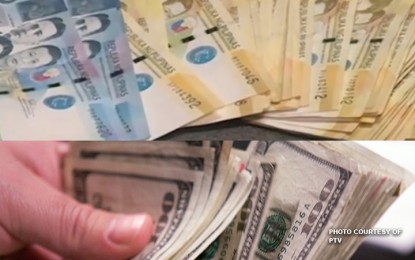
STEADY POLICY. The peso continues to fall victim to the US dollar's strengthening but authorities said the local currency remains in the middle of the pack in terms of depreciation among Asian currencies. Monetary authorities said monetary policy tools are being used to help tame inflation rate as well as help buoy the peso. (PNA file photo)
#PBBMSONA2022
MANILA – Monetary authorities maintain that a market-determined exchange rate policy is still good for the Philippine peso despite its depreciation.
To date, the peso is trading at 56-level against the greenback, a far cry from its 53-level at the start of the year.
The local unit has depreciated by around 10 percent against the greenback since the start of the year but authorities said this performance remains at the middle compared to its counterparts in the region.
President Ferdinand “Bongbong” Marcos Jr. earlier said the rise in domestic inflation rate is due mainly to imported inflation, referring to the impact of the higher oil prices, among others.
Thus the need to help tame faster inflation rate with the help of monetary policy adjustments.
“Our monetary policy right now is essentially to use (the) interest rate to hold, to take control (of the) the inflation rate. We are not looking specifically to exchange rate now,” he said in an earlier briefing in Malacañang.
The National Economic and Development Authority (NEDA) said the 7.5 percent peso depreciation since the Federal Reserve announced its first-rate hike of 0.25 percentage points last March 16 is broadly comparable to those experienced by the Thailand baht (9.1 percent), Malaysia ringgit (5.8 percent), and Indonesia rupiah (4.6 percent).
Although the local unit is currently trading at 56-level against the US dollar to date, authorities said its average for the year remains within the inter-agency Development Budget Coordination Committee’s (DBCC) foreign currency assumption for this year of between 51 to 53.
Bangko Sentral ng Pilipinas (BSP) Governor Felipe Medalla has traced the current peso weakness to the strengthening of the US dollar, buoyed partly by the continued increase in the Federal funds rate.
He thus raised the need to be “on their toes” regarding policy rate adjustments vis-à-vis the central bank’s mandate of price stability and the need to help address the impact of rising inflation rate. BSP’s key rates have been raised by a total of 150 basis points to date -- 25 basis points last May, 50 basis points last June, and the off-cycle 75 basis points last July 14.
These brought the central bank’s overnight reverse repurchase (RRP) rate to 3.25 percent, the overnight deposit rate to 2.75 percent, and the overnight repurchase (RP) rate to 3.75 percent.
Medalla said the continued recovery of the domestic economy gives the policy-making Monetary Board (MB) the leeway to hike the central bank’s key rates because it can absorb the impact of the rate adjustments.
He maintained that “it’s not prudent to let factors that significantly affect the exchange rate to add further to inflation that (is) already high.”
“And because of this, the BSP is prepared to be more aggressive in raising its policy rates, compared to its initial gradualist stance,” he said.
The rate of price increases in the country accelerated further to 6.1 percent last June from the previous month’s 5.4 percent.
The average inflation in the first half of the year stood at 4.4 percent, already above the government’s 2 to 4 percent target band.
The BSP forecasts inflation to average at 5 percent this year. Inflation surpassed the government’s target range last April due largely to upticks in global oil prices and the supply constraints on some food items.
Monetary authorities have repeatedly backed the implementation of non-monetary measures to help address the impact of elevated inflation rate on domestic prices since the rise in inflation rate was traced primarily to supply-side factors.
On the supply side, the NEDA said the government has been accelerating measures to ease inflationary pressures, such as the temporary reduction of import tariffs for pork, rice, coal and corn under Executive Order 171.
EO No. 171 extends the validity of EO 134 and 135, which lowered the most favored nation (MFN) tariff rates for the importation of pork and rice. It also reduces MFN tariff rates for corn to 5 percent in-quota and 15 percent out-quota, citing that corn accounts for over 50 percent of the total production cost of large-scale broiler and swine farms.
The country is also implementing programs that help boost production, such as the National Rice Program, credit and extension services, and the “Plant, Plant, Plant” Program that aimed at addressing the challenges brought by the pandemic to the local food systems.
However, since second round effects of the higher inflation rate have materialized, such as the upticks in minimum fare in public utility vehicles and on workers’ minimum pay, monetary authorities said an aggressive monetary policy is now necessary.
Medalla remains open to another rate increase during the next rate-setting meeting of the MB on August 18, adding that the Board remains data-dependent in terms of their policy decisions.
Impacts
The NEDA said a higher foreign exchange rate is a “positive development” for Philippine exporters of goods and services, including business process outsourcing (BPO) and tourism-related sectors, which may gain price competitiveness vis-à-vis competitor countries.
“Overseas Filipinos and their dependents also benefit as they receive more pesos for every dollar. The government also earns higher revenues from imports,” it said.
However, a higher foreign exchange rate increases the domestic price of imported goods and services purchased by firms and consumers.
Moreover, a weak peso increases the cost of servicing foreign debt owed by the government and the private sector, it added. (PNA)
